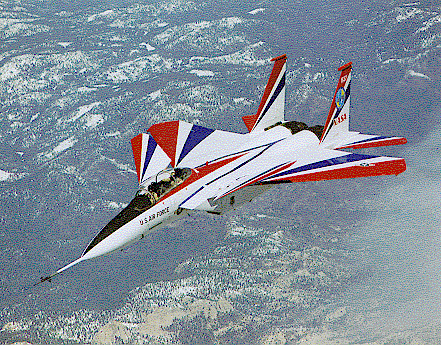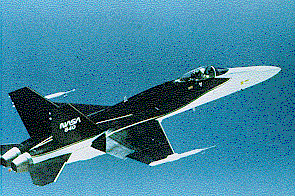 |
|||||
| Home | Research | For Teachers | HISTORY Level 1 Level 2 Level 3 |
PRINCIPLES Level 1 Level 2 Level 3 |
CAREER Level 1 Level 2 Level 3 |
| Gallery | Hot Links | What's New! | |||
| Web Administration and Tools | |||||
 |
|||||
| Home | Research | For Teachers | HISTORY Level 1 Level 2 Level 3 |
PRINCIPLES Level 1 Level 2 Level 3 |
CAREER Level 1 Level 2 Level 3 |
| Gallery | Hot Links | What's New! | |||
| Web Administration and Tools | |||||
![]()
In March 1996, NASA initiated flight testing of a new thrust vectoring concept that
could lead to significant increases in the performance of both civil and military aircraft
flyingat subsonic or supersonic speed.
The tests at Dryden Flight Research Center are part of a program known as ACTIVE (Advanced
Controls Technology for Integrated Aircraft), a collaborative effort of NASA, the Air
Force's Wright Laboratory, McDonnell Douglas Aerospace (MDA), and Pratt & Whitney
Government Engines & Space Propulsion unit (POW).
The test aircraft is a twin-engine F-15 ACTIVE, a modified version of the Air Force F-15B
fighter built by MDA and powered by F-100PW-229 engines, each of which is equippedwith a
nozzle that can swivel 20 degrees in any direction, giving the aircraft thrust control
inthe pitch (up and down) and yaw (left-right) directions. This vectored (deflected)
thrust system could replace conventional drag inducing aerodynamic controls and thereby
gain increased fuel economy or range.
The tests began with four flights in March/April, then progressed to the first supersonic
flight on April 24. On that occasion, the F-15 ACTIVE successfully demonstrated both
pitchand yaw deflections at speeds of Mach 1.2 to1.5. The flight test plan contemplated
about 60 flights totaling 100 hours at speeds up to Mach 1.85 and angles of attack (the
angle betweenthe aircraft's body/wings and its actual flight path) up to 30 degrees.

The F-15 ACTIVE is exploringa vectored thrust system thatcould
replace convenhonalaerodynamic control surfaces.
The F-15 ACTIVE program is representative ofthe type of flight research conducted by
NASA to explore new technologies and new flightregimes. NASA conducts such
programsindependently or in cooperation with U.S.industry and the Department of
Defense,sometimes in cooperation with internationaldevelopment teams.
Another example of a Dryden flight researchprogram is NASA's High Alpha investigation.High
Alpha refers to high angles of attack, aflight regime in which the airflow
becomesextremely complex. To provide aircraft manufacturers with a technology base for
designinghigh performance aircraft capable of"supermaneuverability" and of
maintainingstability/controllability at high angles of attack,NASA conducted the
decade-long High Alphaprogram that concluded on May 29, 1996 withthe final flight of
NASA's F-18 HARV (HighAlpha Research Vehicle).
In the first phase of the program, initiated in1987, the F-18 HARV explored angles of
attackup to 55 degrees. In the second phase, NASA investigated thrust vectoring technology
to determine the impact on aircraft maneuverability at high angles of attack. In the final
phase, the F-18 HARV's handling qualities were evaluated by 14 different pilots
representing NASA, the Department of Defense, and support contractors McDonnell Douglas
Aerospace and Calspan Corporation.
Among other flight projects under way at Dryden are two examples of test programs intended
to support NASA activities not directly connected with aeronautics advancement. One is a
project involving airborne tests of an advanced thermal protection system (TPS) for use on
the X-33 Reusable Launch Vehicle. The project employs an F-15B Flight Test Fixture-II
(FTF-II) aircraft foratmospheric testing (the ascent and landing phases of the launch
vehicle's operation), where the potential threat to the TPS is impact with rain drops,
cloud droplets or ice crystals. Test participants include Marshall Space Flight Center and
Rockwell International.

NASA's veteran F-18 HARV research aircraft concluded adecade
Jongflight test program that explored aircraft maneuverability
and controllability at high angles of attack.
Another new program involves testing the Theseus, a robot aircraft to be employed in NASA's Mission To Planet Earth program for research in such areas as stratospheric ozone depletion and the atmospheric effects of future high speed civil transport engines. Built by Aurora Flight Sciences Corporation, Fairmont,West Virginia, Theseus is a twin-engine propeller-driven craft with a 143-footwingspan. Constructed largely of composite materials, it is capable of carrying 700 pounds of science instruments to altitudes above 60,000 feet for durations of more than 24 hours. The planemade its initial flight at Dryden in May 1996.
Visit our Video Gallery for
streaming videos on the F-18 HARV.
![]()
Send all comments to ![]() aeromaster@eng.fiu.edu
aeromaster@eng.fiu.edu
© 1995-98 ALLSTAR Network. All rights reserved worldwide.
Updated: February 17, 1999